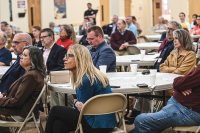Archived News
Macon slope committee hands off proposed building regulations
After months of hard work, Macon County’s steep slope committee shared its recommendations with the county’s planning board last week.
Now the question is whether the committee’s work will survive with its core principles intact if or when it is adopted by the county commissioners.
“There is going to come a time that the commissioners are going to have to step up to the plate,” said County Chairman Ronnie Beale. “This is the first opening of the book.”
A committee with a cross-section of building and environmental interests met 10 times over a period of eight months, but the initial meetings defined the mission.
“During the first two meetings we determined we would try to approach this from a public safety standpoint and from the standpoint of minimizing property damage,” said Al Slagle, the steep slope committee chairman.
That decision meant the committee would not consider regulating slope development for environmental or aesthetic reasons, said committee member Susan Ervin, a member of the planning board.
The recommendations include two sets of standards: one for slopes between 30 and 40 percent and one for slopes over 40 percent. Developers will have to hire an engineer when building on the steeper slopes, but in the middle window, county staff will perform in-house inspections.
The two-tiered approach was an attempt to minimize the cost burden on developers and the county, but Slagle said the committee also determined the county would need a more robust oversight apparatus.
“One of the things we decided was if we’re going to try to level the playing field, it’s going to take some additional county personnel to enforce things,” Slagle said. “Right now a lot of enforcement is based on complaints, and we felt we needed a way to track grading and land disturbance projects.”
A group of grading contractors, developers and builders attended the meeting to learn about the committee’s recommendations. Many of their questions centered on how the regulations would be enforced and how they would shift the cost burden for building on mountainsides.
One local builder asked the committee to consider the financial impact of their recommendations, citing a recent single family home project that required close to $20,000 in additional costs due to engineering fees. Others said the building industry couldn’t support more regulations in the poor economy.
Paul Shuler, a grading contractor who sat on the committee, explained the predicament of having no regulation over steep slope projects.
“I go out here and give a man a price according to the regulations and then this other yahoo comes in and puts a road in for a third of the cost,” Shuler said. “And it washes away three months later and they ask me to come fix it. We’re trying to get in on the same playing field so the roads don’t wash away.”
Stacey Guffey, former planning director and a member of the slope committee, put the discussion in perspective.
“You have to ask ‘What does it cost the builder? What does it cost the developer?’ But you also have to ask ‘What will it cost the taxpayers if we don’t do this?’” Guffey said.
Lewis Penland, chairman of the planning board, was pleased by the lively discussion inspired by the committee’s findings. He applauded the concerned developers and builders who voiced their opinions. He said the regulations are really aimed at contractors who exploit the system.
“I think the unfortunate thing about tonight is the people who should be here aren’t here,” Penland said. “I’m as mountain as anybody, and I don’t like regulation, but I can’t see any other way to fix the problem.”
The county planning board will debate the committee’s findings during next month’s meeting. The planning board can endorse all or some of the recommendations and decide whether to send them on for the commissioners’ consideration.
Commissioner Bobby Kuppers, the county board’s liaison on the planning board, applauded the committee’s work.
“It’s easy to do things that are easy. It’s easy to pick the low hanging fruit,” Kuppers said. “What this committee did was climb up the tree a little bit.”
Kuppers also foreshadowed the difficulties facing the commissioners as they balance the slope committee’s recommendations and the concerns of developers.
“You can’t keep dodging a decision just because it’s hard,” Kuppers said.
Chairman Ronnie Beale said steep slopes need to be dealt with, but he didn’t commit to a timetable.
“I think that steep slopes are one of those things we’ll have to address,” Beale said. “Is this the right time? I don’t know. But I don’t know that there will ever be a good time.”
For any development on slopes over 30 percent grade:
• Cut slopes over 8 feet in vertical height cannot be steeper than 1.5:1 ratio.
• Fill slopes over 5 feet in vertical height cannot be steeper than 2:1.
• No cut-and-fill slope can exceed 30 vertical feet.
• Fill must be compacted and cannot contain stumps and logs.
• For development on slopes between 30 and 40 percent grade, an engineer is not required but a site plan, showing the areas to be graded, cut/fill heights, drainage plan, is required.
• On slopes greater than 40 percent, developer must hire an engineer or design professional to create a certified plan. Engineer also required on slopes greater than 30 percent if they lie in high or moderate landslide hazard areas.
• The ordinance applies only to the portion of a tract that exceeds the slope threshold, not the entire tract.
Now the question is whether the committee’s work will survive with its core principles intact if or when it is adopted by the county commissioners.
“There is going to come a time that the commissioners are going to have to step up to the plate,” said County Chairman Ronnie Beale. “This is the first opening of the book.”
A committee with a cross-section of building and environmental interests met 10 times over a period of eight months, but the initial meetings defined the mission.
“During the first two meetings we determined we would try to approach this from a public safety standpoint and from the standpoint of minimizing property damage,” said Al Slagle, the steep slope committee chairman.
That decision meant the committee would not consider regulating slope development for environmental or aesthetic reasons, said committee member Susan Ervin, a member of the planning board.
The recommendations include two sets of standards: one for slopes between 30 and 40 percent and one for slopes over 40 percent. Developers will have to hire an engineer when building on the steeper slopes, but in the middle window, county staff will perform in-house inspections.
The two-tiered approach was an attempt to minimize the cost burden on developers and the county, but Slagle said the committee also determined the county would need a more robust oversight apparatus.
“One of the things we decided was if we’re going to try to level the playing field, it’s going to take some additional county personnel to enforce things,” Slagle said. “Right now a lot of enforcement is based on complaints, and we felt we needed a way to track grading and land disturbance projects.”
A group of grading contractors, developers and builders attended the meeting to learn about the committee’s recommendations. Many of their questions centered on how the regulations would be enforced and how they would shift the cost burden for building on mountainsides.
One local builder asked the committee to consider the financial impact of their recommendations, citing a recent single family home project that required close to $20,000 in additional costs due to engineering fees. Others said the building industry couldn’t support more regulations in the poor economy.
Paul Shuler, a grading contractor who sat on the committee, explained the predicament of having no regulation over steep slope projects.
“I go out here and give a man a price according to the regulations and then this other yahoo comes in and puts a road in for a third of the cost,” Shuler said. “And it washes away three months later and they ask me to come fix it. We’re trying to get in on the same playing field so the roads don’t wash away.”
Stacey Guffey, former planning director and a member of the slope committee, put the discussion in perspective.
“You have to ask ‘What does it cost the builder? What does it cost the developer?’ But you also have to ask ‘What will it cost the taxpayers if we don’t do this?’” Guffey said.
Lewis Penland, chairman of the planning board, was pleased by the lively discussion inspired by the committee’s findings. He applauded the concerned developers and builders who voiced their opinions. He said the regulations are really aimed at contractors who exploit the system.
“I think the unfortunate thing about tonight is the people who should be here aren’t here,” Penland said. “I’m as mountain as anybody, and I don’t like regulation, but I can’t see any other way to fix the problem.”
The county planning board will debate the committee’s findings during next month’s meeting. The planning board can endorse all or some of the recommendations and decide whether to send them on for the commissioners’ consideration.
Commissioner Bobby Kuppers, the county board’s liaison on the planning board, applauded the committee’s work.
“It’s easy to do things that are easy. It’s easy to pick the low hanging fruit,” Kuppers said. “What this committee did was climb up the tree a little bit.”
Kuppers also foreshadowed the difficulties facing the commissioners as they balance the slope committee’s recommendations and the concerns of developers.
“You can’t keep dodging a decision just because it’s hard,” Kuppers said.
Chairman Ronnie Beale said steep slopes need to be dealt with, but he didn’t commit to a timetable.
“I think that steep slopes are one of those things we’ll have to address,” Beale said. “Is this the right time? I don’t know. But I don’t know that there will ever be a good time.”
Macon County’s proposed steep slope rules
For any development on slopes over 30 percent grade:
• Cut slopes over 8 feet in vertical height cannot be steeper than 1.5:1 ratio.
• Fill slopes over 5 feet in vertical height cannot be steeper than 2:1.
• No cut-and-fill slope can exceed 30 vertical feet.
• Fill must be compacted and cannot contain stumps and logs.
• For development on slopes between 30 and 40 percent grade, an engineer is not required but a site plan, showing the areas to be graded, cut/fill heights, drainage plan, is required.
• On slopes greater than 40 percent, developer must hire an engineer or design professional to create a certified plan. Engineer also required on slopes greater than 30 percent if they lie in high or moderate landslide hazard areas.
• The ordinance applies only to the portion of a tract that exceeds the slope threshold, not the entire tract.





